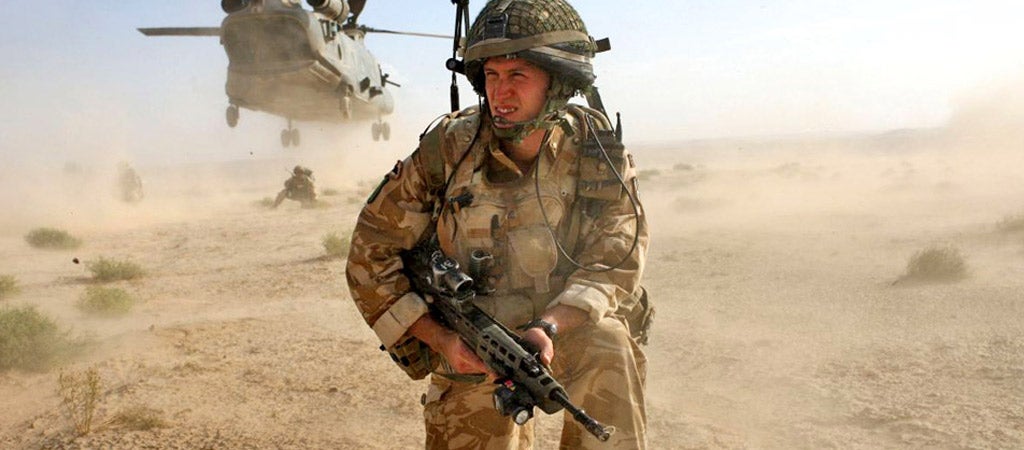Territorials to fill in gaps as Army numbers cut to lowest level since the 19th century
Forces morale 'fragile' as Government reveals whole Infantry battalions will be scrapped

Morale among troops is “fragile”, the Defence Secretary admitted today as he set out plans to cut the Army to its smallest size since the 19th century.
Philip Hammond announced that five infantry battalions and 12 other units would be axed in moves to reduce the manpower of the regular Army from its current 102,000 to 82,000 by 2020.
The planned reductions, which are part of a drive to cut defence spending by more than £4bn, were condemned by MPs of all parties in angry Commons scenes. The Army will be split into two sections – a “reaction force” on standby for deployment to trouble-spots and an “adaptable force” to back it up.
The number of reservists will be boosted to compensate for the cutbacks and ministers are drawing up plans to approach major employers to release staff in the Territorial Army for longer periods. Mr Hammond admitted today that the planned redundancies and disappearance of historic battalions was having an impact on the spirits of servicemen and women.
“Morale is fragile. We have a lot of work to do to take our people through these big changes.” he said. “People never like change – change brings uncertainty.”
There were cries of “shame” from MPs as he announced that four infantry battalions – the 2nd Battalion the Royal Regiment of Fusiliers, the 2nd Battalion the Yorkshire Regiment (Green Howards), the 3rd Battalion the Mercian Regiment, and the 2nd Battalion the Royal Welsh – will disappear.
A fifth, the 5th Battalion the Royal Regiment of Scotland (Argyll and Sutherland Highlanders), will be turned into a “public duties company” carrying out ceremonial duties in Scotland. The Armoured Corps will be reduced by two units with the merger of the Queen’s Royal Lancers and the 9th/12th Royal Lancers and the 1st and 2nd Tank Regiments amalgamating.
There will also be reductions in the number of units in the Royal Artillery, the Royal Engineers, the Army Air Corps, the Royal Logistic Corps, the Royal Electrical and Mechanical Engineers and the Royal Military Police.
Mr Hammond said: “These withdrawals and mergers, unwelcome as I know they will be in the units affected, are fair and balanced and have been carefully structured to minimise the impact of the regular manpower reduction and maximise the military effectiveness of the Army.”
Almost 7,000 redundancies have already been announced and they will be followed by about another 11,000 in two tranches over the next two years, with the result that some troops receive their redundancy notices as the Army pulls out of Afghanistan.
General Sir Peter Wall, the chief of the general staff, said the plans would make Britain’s forces “better integrated and fully adaptable”. But he admitted he wished the changes could take effect quicker, rather than hang over the Army for several years.
He said: “I believe that drawing this out over a period of four or five years is going to be wearing on our people,” adding that decisions on where to make the cuts had been based on the recruiting records and population trends in the areas affected.
The moves have already attracted heavy criticism at senior levels within the Army. In a leaked letter to Gen Wall, a brigadier in the Royal Regiment of Fusiliers protested that plans to axe one of its two battalions would not “best serve” the armed forces and “cannot be presented as the best or most sensible military option”.
Lord Dannatt, the former head of the Army, said: “Let’s hope the next decade is a rather more peaceful decade that the last decade, but I wouldn’t bet on it.”
The planned reductions are part of a drive to cut defence spending by more than £4bn.
Losing battle: Four battalions to go
2nd Battalion the Royal Welsh
Formed in: 2006
Based in: Tidworth, Wiltshire
The Royal Welsh Regiment in its present form was created six years ago from three former regiments, but the 2nd Battalion can trace its history as far back as Rorke’s Drift – a famous battle that took place during the 1879 Zulu War.
The unit will cease to exist after being merged with the 1st Battalion, in an effort to “strengthen the operational nature of the armed forces in Wales”, according to the Welsh Conservatives leader Andrew RT Davies.
2nd Battalion the Royal Fusiliers
Formed in: 1968
Based in: Celle, Germany
Formed from by the amalgamation of four historic regiments, including the Lancashire Fusiliers, whose soldiers famously won 'six Victoria Crosses before breakfast' during the First World War Gallipoli landings in 1915.
More recently, a company from the 2nd Battalion fought the longest defensive battle since the Korean War in 2007 in Helmand province, Afghanistan.
1st and 2nd Royal Tank Regiments (merged)
Formed in: 1917
Based in: Tidworth, Wiltshire
The Royal Tank Regiment is the oldest tank unit in the world.
The 2nd Regiment famously broke through the German trenches at Cambrai, France, in 1917, during the First World War.
The government has justified the cuts to tanks by stressing the need for more diverse armoured divisions. Britain’s last tank battle was in 2003. Defending the move, the MoD said: “Modern armies require more than just tanks.”
5th Battalion the Royal Regiment of Scotland
Formed in: 2006
Based in: Canterbury, Kent
The Argyll and Sutherland Highlanders, 5th Battalion can trace its roots back to 1881, and fought major campaigns in both world wars.
The 5th Battalion will now be reduced to a public duties company to carry out ceremonial roles in Scotland. David Cameron was urged to cut more battalions from Scottish regiments, but was reportedly reluctant to do so to avoid handed a public relations coup to Alex Salmond, leader of the Scottish National Party.
Join our commenting forum
Join thought-provoking conversations, follow other Independent readers and see their replies
Comments